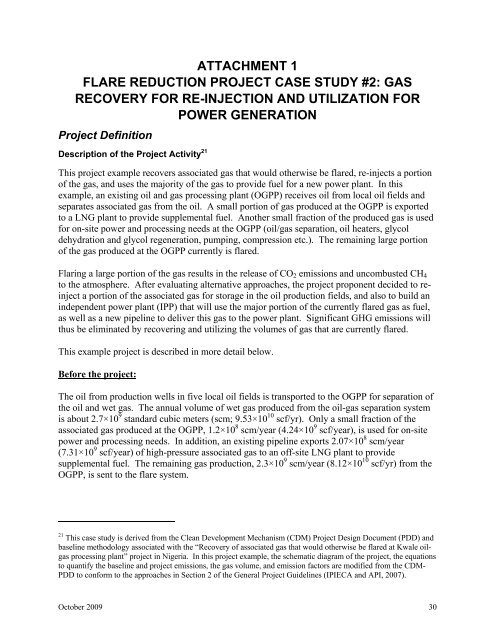Part III: Flare Reduction Project Family - IPIECA
Part III: Flare Reduction Project Family - IPIECA
Part III: Flare Reduction Project Family - IPIECA
Create successful ePaper yourself
Turn your PDF publications into a flip-book with our unique Google optimized e-Paper software.
ATTACHMENT 1<br />
FLARE REDUCTION PROJECT CASE STUDY #2: GAS<br />
RECOVERY FOR RE-INJECTION AND UTILIZATION FOR<br />
POWER GENERATION<br />
<strong>Project</strong> Definition<br />
Description of the <strong>Project</strong> Activity 21<br />
This project example recovers associated gas that would otherwise be flared, re-injects a portion<br />
of the gas, and uses the majority of the gas to provide fuel for a new power plant. In this<br />
example, an existing oil and gas processing plant (OGPP) receives oil from local oil fields and<br />
separates associated gas from the oil. A small portion of gas produced at the OGPP is exported<br />
to a LNG plant to provide supplemental fuel. Another small fraction of the produced gas is used<br />
for on-site power and processing needs at the OGPP (oil/gas separation, oil heaters, glycol<br />
dehydration and glycol regeneration, pumping, compression etc.). The remaining large portion<br />
of the gas produced at the OGPP currently is flared.<br />
Flaring a large portion of the gas results in the release of CO 2 emissions and uncombusted CH 4<br />
to the atmosphere. After evaluating alternative approaches, the project proponent decided to reinject<br />
a portion of the associated gas for storage in the oil production fields, and also to build an<br />
independent power plant (IPP) that will use the major portion of the currently flared gas as fuel,<br />
as well as a new pipeline to deliver this gas to the power plant. Significant GHG emissions will<br />
thus be eliminated by recovering and utilizing the volumes of gas that are currently flared.<br />
This example project is described in more detail below.<br />
Before the project:<br />
The oil from production wells in five local oil fields is transported to the OGPP for separation of<br />
the oil and wet gas. The annual volume of wet gas produced from the oil-gas separation system<br />
is about 2.7×10 9 standard cubic meters (scm; 9.53×10 10 scf/yr). Only a small fraction of the<br />
associated gas produced at the OGPP, 1.2×10 8 scm/year (4.24×10 9 scf/year), is used for on-site<br />
power and processing needs. In addition, an existing pipeline exports 2.07×10 8 scm/year<br />
(7.31×10 9 scf/year) of high-pressure associated gas to an off-site LNG plant to provide<br />
supplemental fuel. The remaining gas production, 2.3×10 9 scm/year (8.12×10 10 scf/yr) from the<br />
OGPP, is sent to the flare system.<br />
21 This case study is derived from the Clean Development Mechanism (CDM) <strong>Project</strong> Design Document (PDD) and<br />
baseline methodology associated with the “Recovery of associated gas that would otherwise be flared at Kwale oilgas<br />
processing plant” project in Nigeria. In this project example, the schematic diagram of the project, the equations<br />
to quantify the baseline and project emissions, the gas volume, and emission factors are modified from the CDM-<br />
PDD to conform to the approaches in Section 2 of the General <strong>Project</strong> Guidelines (<strong>IPIECA</strong> and API, 2007).<br />
October 2009 30

















